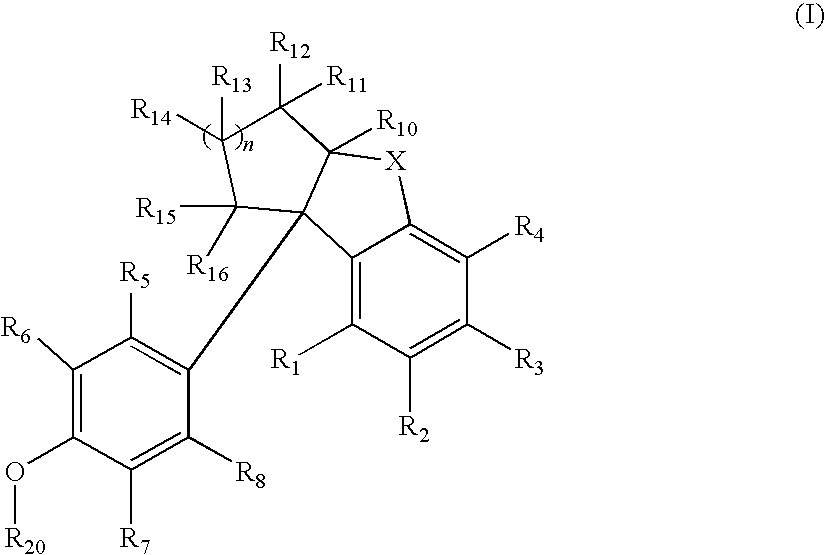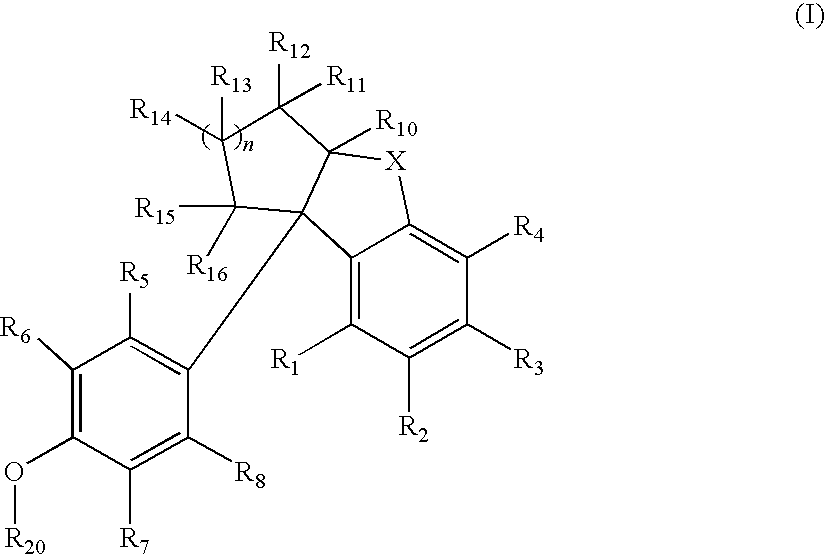Compounds with activity at estrogen receptors
a technology of estrogen receptors and compounds, applied in the field of compounds with estrogen receptor activity, can solve the problems of increased aggression and infanticide, lack of sexual behavior of females, lack of breast tissue development, etc., and achieve the effects of reducing inflammation, reducing ifn- levels, and reducing il-4 levels
- Summary
- Abstract
- Description
- Claims
- Application Information
AI Technical Summary
Benefits of technology
Problems solved by technology
Method used
Image
Examples
example 1
Analytical Procedure
[0260]Analyses were performed on a combined prep / analytical Waters / Micromass system consisting of a ZMD single quadropole mass spectrometer equipped with electro-spray ionization interface. The HPLC system consisted of a Waters 600 gradient pump with on-line degassing, a 2700 sample manager and a 996 PDA detector.
[0261]Separation was performed on an X-Terra MS C18, 5 μm 4.6×50 mm column. Buffer A: 10 mM ammonium acetate in water, buffer B: 10 mM ammonium acetate in acetonitrile / water 95 / 5. A gradient was run from 10% B to 100% B in 10 min, stay at 100% B for 1 min, re-equilibrate for 6 min. The system was operated at 1 mL / min.
[0262]For some analyses, separation was performed on an X-Terra MS C18, 5 μm 4.6×50 mm column. Buffer A: 10 mM ammonium acetate in water, buffer B: 10 mM ammonium acetate in acetonitrile / water 95 / 5. A gradient was run from 30% B to 100% B in 7 min, stay at 100% B for 1 min, re-equilibrate for 5.5 min. The system was operated at 1 mL / min.
example 2
(4-Benzyloxy-phenyl)-phenyl-methanone (1)
[0263]
[0264]The standard procedure for the benzylation of phenols is exemplified by the synthesis of (4-Benzyloxy-phenyl)-phenyl-methanone (1).
[0265]NaH (60% in mineral oil, 1.2 g, 30 mmol) was added to an ice-cooled solution of (4-hydroxy-phenyl)-phenyl-methanone (5 g, 25.2 mmol) in DMF (25 mL). The resulting mixture was stirred for 20 minutes at room temperature (r.t.). Benzyl bromide (6.1 mL, 50 mmol) was added at 0° C. The reaction temperature was raised to r.t. after 1 h and thereafter stirred for additional 2 h. Water (20 mL) was added and the aqueous phase was extracted with dichloromethane (2×30 mL). The combined organic phase was concentrated and purified by flash chromatography (eluent: 100% dichloromethane). Yield: 7.0 g, 96% of 1. 1H NMR (400 MHz, CDCl3): δ 7.83 (d, J=8.4 Hz, 2H), 7.77 (d, J=7.2 Hz, 2H), 7.58-7.52 (m, 1H), 7.50-7.32 (m, 7H), 7.03 (d, J=8.4 Hz, 2H), 5.17 (s, 2H).
example 3
(4-Benzyloxy-phenyl)-2-fluorophenyl-methanone (2)
[0266]
[0267]The title compound 2 was synthesized from (2-fluorophenyl)(4-hydroxyphenyl)methanone (2.0 g) using the procedure described for the synthesis of compound 1. Yield: 2.4 g, (96%). 1H-NMR (400 MHz, CDCl3): δ ppm 7.86-7.72 (m, 2H), 7.50-7.42 (m, 2H), 7.41-7.28 (m, 5H), 7.25-7.17 (m, 1H), 7.15-7.07 (m, 1H), 7.02-6.94 (m, 2H), 5.10 (s, 2 H).
PUM
| Property | Measurement | Unit |
|---|---|---|
| temperature | aaaaa | aaaaa |
| temperature | aaaaa | aaaaa |
| pH | aaaaa | aaaaa |
Abstract
Description
Claims
Application Information
 Login to View More
Login to View More - R&D
- Intellectual Property
- Life Sciences
- Materials
- Tech Scout
- Unparalleled Data Quality
- Higher Quality Content
- 60% Fewer Hallucinations
Browse by: Latest US Patents, China's latest patents, Technical Efficacy Thesaurus, Application Domain, Technology Topic, Popular Technical Reports.
© 2025 PatSnap. All rights reserved.Legal|Privacy policy|Modern Slavery Act Transparency Statement|Sitemap|About US| Contact US: help@patsnap.com



